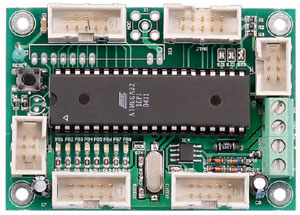Pocket Calculator Control Interface
Communicating with a TI-83(Plus) or TI-84 Plus

Every technician or engineer has a pocket calculator somewhere on their desk. Although the internal processes of these calculators are hardly suitable for control tasks, some of them can be used to build a nice robot.
This is a MEMBER ONLY article. You need a subscription to read this article.
- Access to Elektor archive and 5,000+ Gerber files
- Receive up to 8 magazines per year (digital and/or paper)
- 10% discount in the Elektor store
Available from €4.95 per month.
What is Members Only
Elektor is committed to providing high-quality content on electronics, catering to tens of thousands of paying members. As part of this commitment, Elektor has launched Premium, an initiative that offers exclusive online articles to members sometimes even before they appear in the magazine.
Every day, members can access in-depth articles that showcase the best of Elektor's premium content.
This initiative aims to reward members with early access. Once logged in, members can easily enjoy this exclusive content and engage in discussions about featured projects. While Premium adds to the existing resources available, Elektor will continue to provide a wealth of free information.
Join the Elektor community today to take advantage of Premium and other benefits!
Materials
Gerber file
CAM/CAD data for the PCB referred to in this article is available as a Gerber file. Elektor GREEN and GOLD members can exclusively download these files for free as part of their membership. Gerber files allow a PCB to be produced on an appropriate device available locally, or through an online PCB manufacturing service.
Elektor recommends the Elektor PCB Service service from its business partner Eurocircuits or AISLER as the best services for its own prototypes and volume production.
The use of our Gerber files is provided under a modified Creative Commons license. Creative Commons offers authors, scientists, educators and other creatives the freedom to handle their copyright in a more free way without losing their ownership.
Extra info / Update
• 32 ESD-protected inputs/outputs including connectivity for I2C, AVR-ISP, JTAG, RS485 and general I/O.
• Supply regulation using 7805
• Firmware all in C
• Simple to program
Component list
Resistors
R1-R5 = 4k?7 (SMD 0805)
R6,R15 = 47? (SMD 0805)
R7-R14 = 1k? (SMD 0805)
Capacitors
C1-C5 = 100nF (SMD 0805)
C6,C9 = 18pF (SMD 0805)
C7,C8 = 10?F 50V
Semiconductors
D1 = SM4007
D2,D4 = 8.2V zener diode
D3,D5 = 4.7V zener diode
IC1 = not fitted
IC2 = ATmega32-P, programmed
IC3 = 7805DT
IC4 = MAX487CSA
PB1-PB8 = LED (SMD 0805)
Miscellaneous
L1 = 10?H
Q1 = 8MHz
PORTB,PORTD,JTAG,ADC = 10-way boxheader
ISP,I2C = 6-way DIL pinheader
POWER,RS485 = PC terminal block, lead pitch 5 mm (0.2”)



Discussion (0 comments)